
Alstonia is a widespread genus of evergreen trees and shrubs, of the family Apocynaceae. It was named by Robert Brown in 1811, after Charles Alston (1685–1760), professor of botany at Edinburgh from 1716 to 1760.

Aleurites is a small genus of arborescent flowering plants in the Euphorbiaceae, first described as a genus in 1776. It is native to China, the Indian Subcontinent, Southeast Asia, Papuasia, and Queensland. It is also reportedly naturalized on various islands as well as scattered locations in Africa, South America, and Florida.
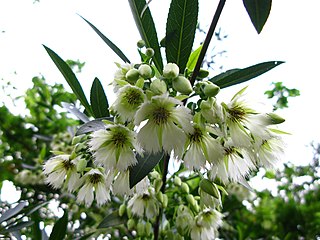
Elaeocarpus is a genus of nearly five hundred species of flowering plants in the family Elaeocarpaceae native to the Western Indian Ocean, Tropical and Subtropical Asia and the Pacific. Plants in the genus Elaeocarpus are trees or shrubs with simple leaves, flowers with four or five usually petals and usually blue fruit.
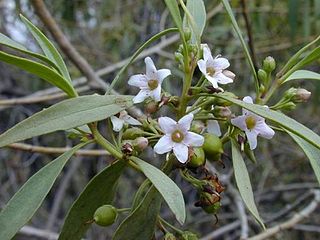
Myoporum is a genus of flowering plants in the figwort family, Scrophulariaceae. There are 30 species in the genus, eighteen of which are endemic to Australia although others are endemic to Pacific Islands, including New Zealand, and one is endemic to two Indian Ocean islands. They are shrubs or small trees with leaves that are arranged alternately and have white, occasionally pink flowers and a fruit that is a drupe.
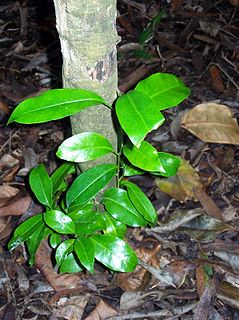
Fontainea is a genus constituting part of the plant family Euphorbiaceae. The nine currently known species grow naturally in Queensland (Qld) and New South Wales (NSW) Australia, New Caledonia and Vanuatu, and Papua New Guinea. Some species are commonly named blushwood.

Petalostigma is a genus of plants under the family Picrodendraceae and the monogeneric subtribe Petalostigmatinae, first defined by von Mueller in 1857. It is native to New Guinea and Australia. They are evergreen, dioecious shrubs or trees.
Romnalda is a genus of monocotyledonous plants in the family Asparagaceae, subfamily Lomandroideae. As of December 2013 four formally named species are known and accepted by botanical science.

Helicia is a genus of 110 species of trees and shrubs, constituting part of the plant family Proteaceae. They grow naturally in rainforests throughout tropical South and Southeast Asia, including India, Sri Lanka, Indochina, Peninsular Malaysia to New Guinea and as far south as New South Wales.

Cerbera floribunda, commonly known as cassowary plum, grey milkwood, or rubber tree, is a plant in the family Apocynaceae which is native to the region from Sulawesi to the Solomon Islands, including north east Queensland.

Homalanthus populifolius, the bleeding heart, native poplar or Queensland poplar, is an Australian rainforest plant in the family Euphorbiaceae. It often appears in areas of rainforest disturbance. Bleeding heart is highly regarded by rainforest regenerators because of its fast growth and use as a pioneer species in rainforest regeneration.
Zieria exsul is a plant in the citrus family Rutaceae and is endemic to a small area of southeast Queensland. It is an open, straggly shrub with hairy branches, three-part leaves and white flowers in groups of up to twelve, the groups longer than the leaves and each flower with four petals and four stamens.
Zieria inexpectata is a plant in the citrus family Rutaceae and endemic to south-eastern Queensland. It is a small, compact shrub with erect, wiry branches, three-part leaves and groups of up to twelve white flowers, the groups longer than the leaves and the flowers with four petals and four stamens. It was unexpectedly discovered by the authors during a field trip and its discovery led to a paper describing the zierias of Queensland, including sixteen new species.
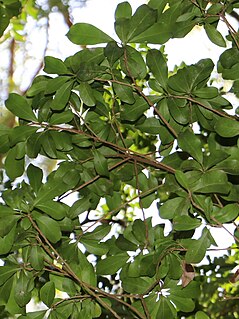
Fontainea venosa, also commonly known as southern blushwood, veiny fontainea, Queensland fontainea and formerly named as Bahrs scrub fontainea is a rare rainforest shrub or tree of the family Euphorbiaceae. It is found in southeastern Queensland, Australia, extending from Boyne Valley to Cedar Creek and is considered vulnerable due to several contributing threats. The total population size is around 200 plants.
Fontainea borealis is a small tree endemic to Papua New Guinea, in the family, Euphorbiaceae, which grows to a height of 12 m.
Fontainea subpapuana is a small tree endemic to Papua New Guinea in the family, Euphorbiaceae, which grows to a height of 7 m.
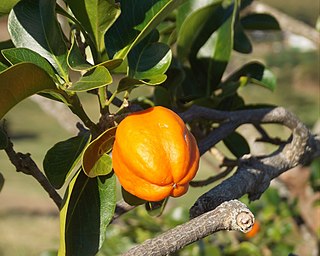
Fontainea pancheri is a small tree or shrub endemic to New Caledonia in the family, Euphorbiaceae, which grows to a height of 15 m.
Phebalium distans, commonly known as the Mt. Berryman phebalium, is a species of small tree that is endemic to south-east Queensland. It is more or less covered with silvery to rust-coloured scales and has warty branchlets, linear leaves and creamy yellow flowers in umbels on the ends of branchlets.

Phebalium longifolium is a species of shrub that is endemic to far north Queensland. It is more or less covered with silvery to rust-coloured scales and has smooth branchlets, narrow elliptical to narrow lance-shaped leaves and cream-coloured flowers in umbels on the ends of branchlets. It grows in the boundary between forest and rainforest in tropical areas.
Pternandra is a genus of trees in the Melastomataceae family. There are 17 species in the taxa. It is native to an area from northern Australia through Southeast Asia to Hainan, Zhōngguó/China and India. The botanist William Jack who named the taxa, died at 27 years of age, the year his description was published.
Hibbertia hexandra, commonly known as tree guinea flower, is a species of flowering plant in the family Dilleniaceae and is endemic to eastern Australia. It is a tall shrub or small tree with mostly lance-shaped leaves with the narrower end towards the base and yellow flowers arranged singly in leaf axils, with six stamens arranged around two hairy carpels.












